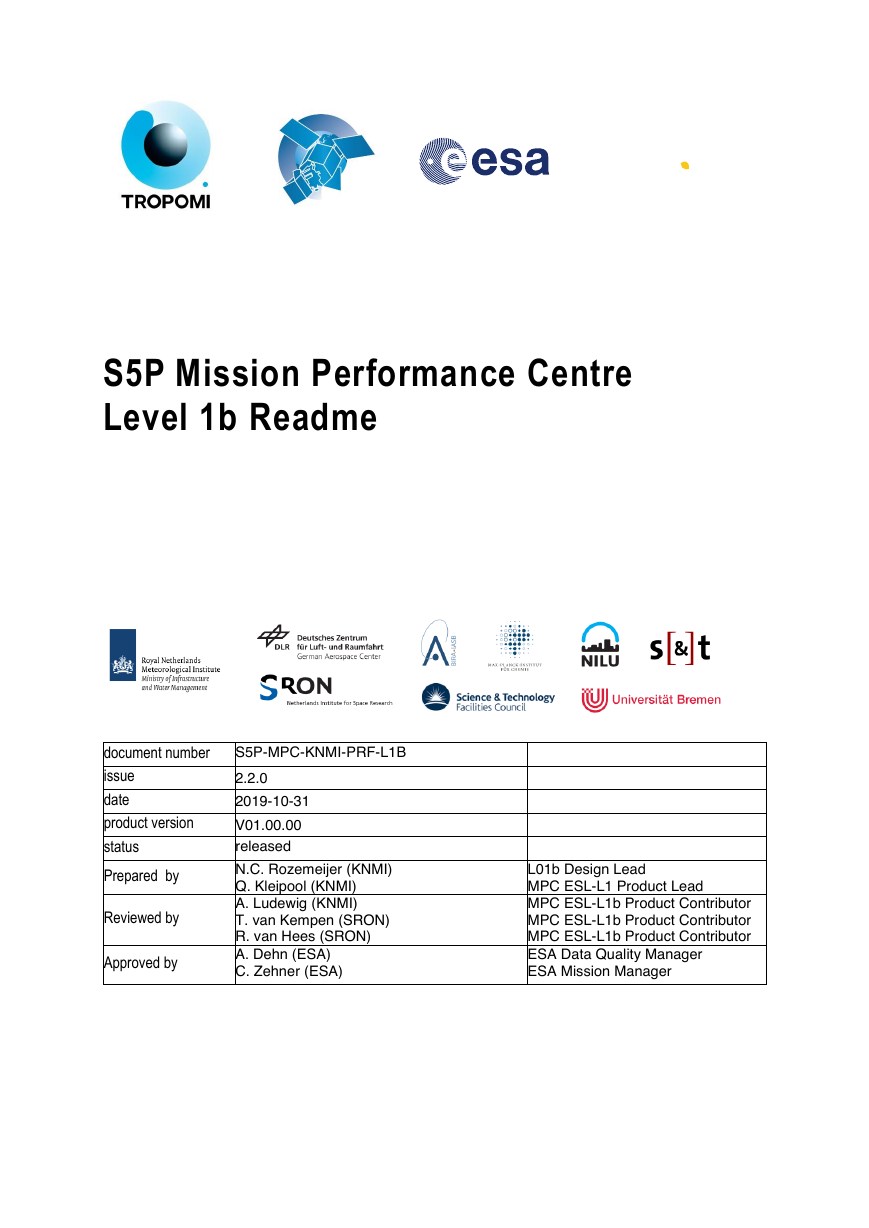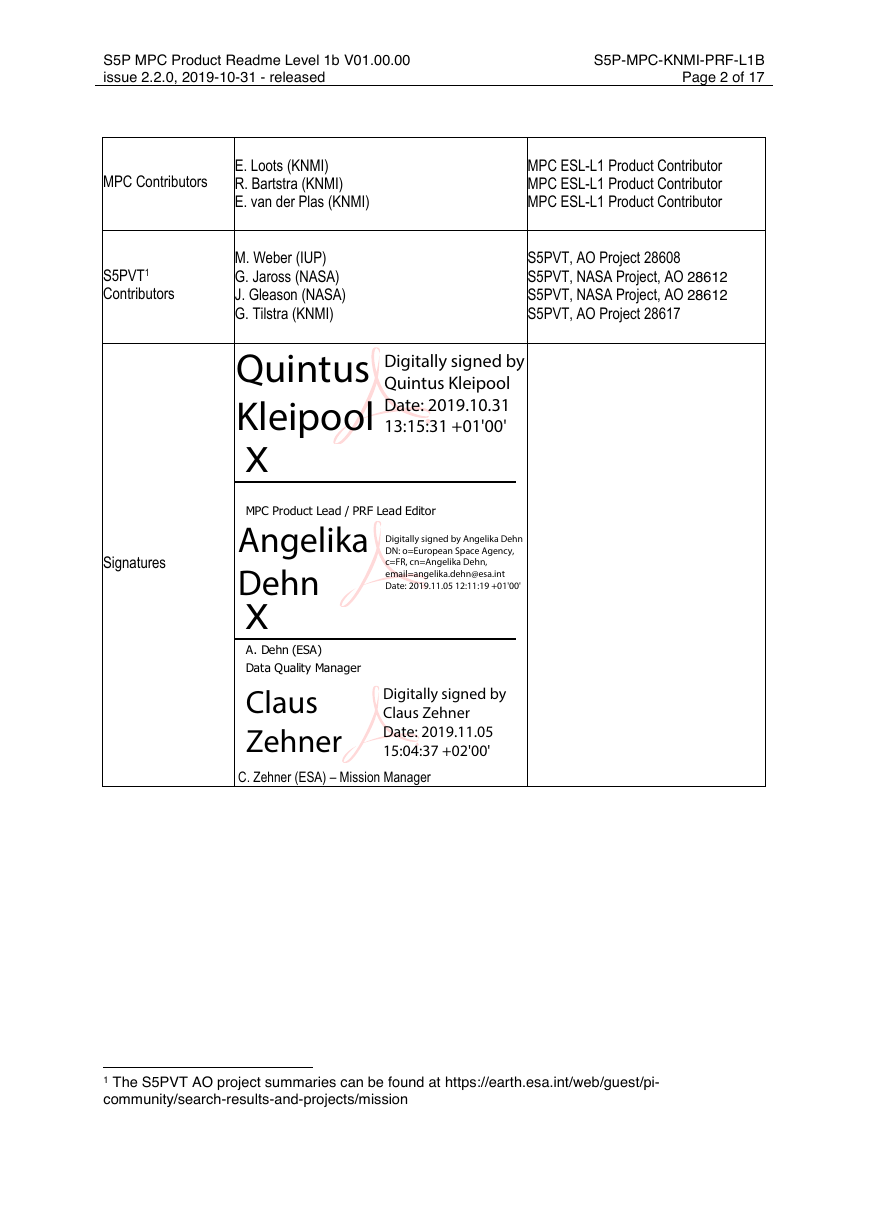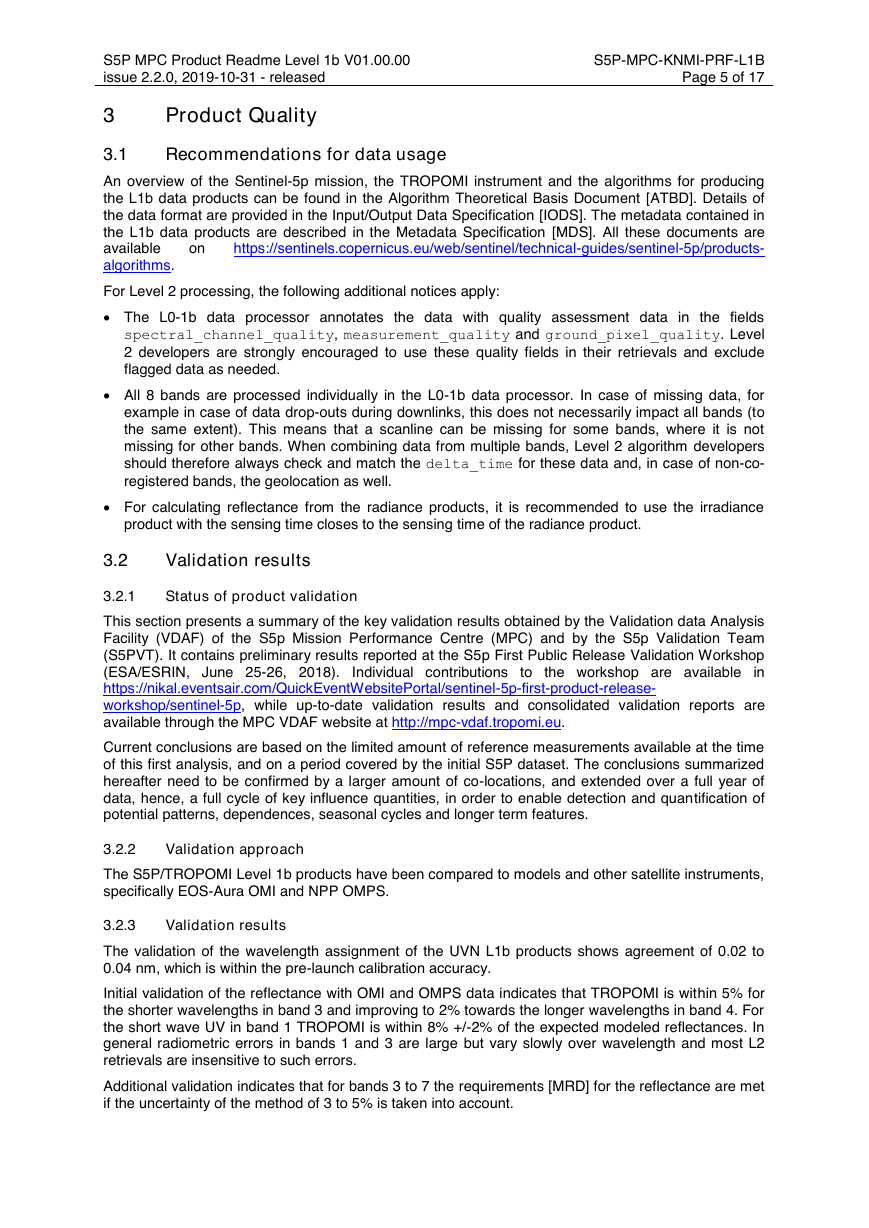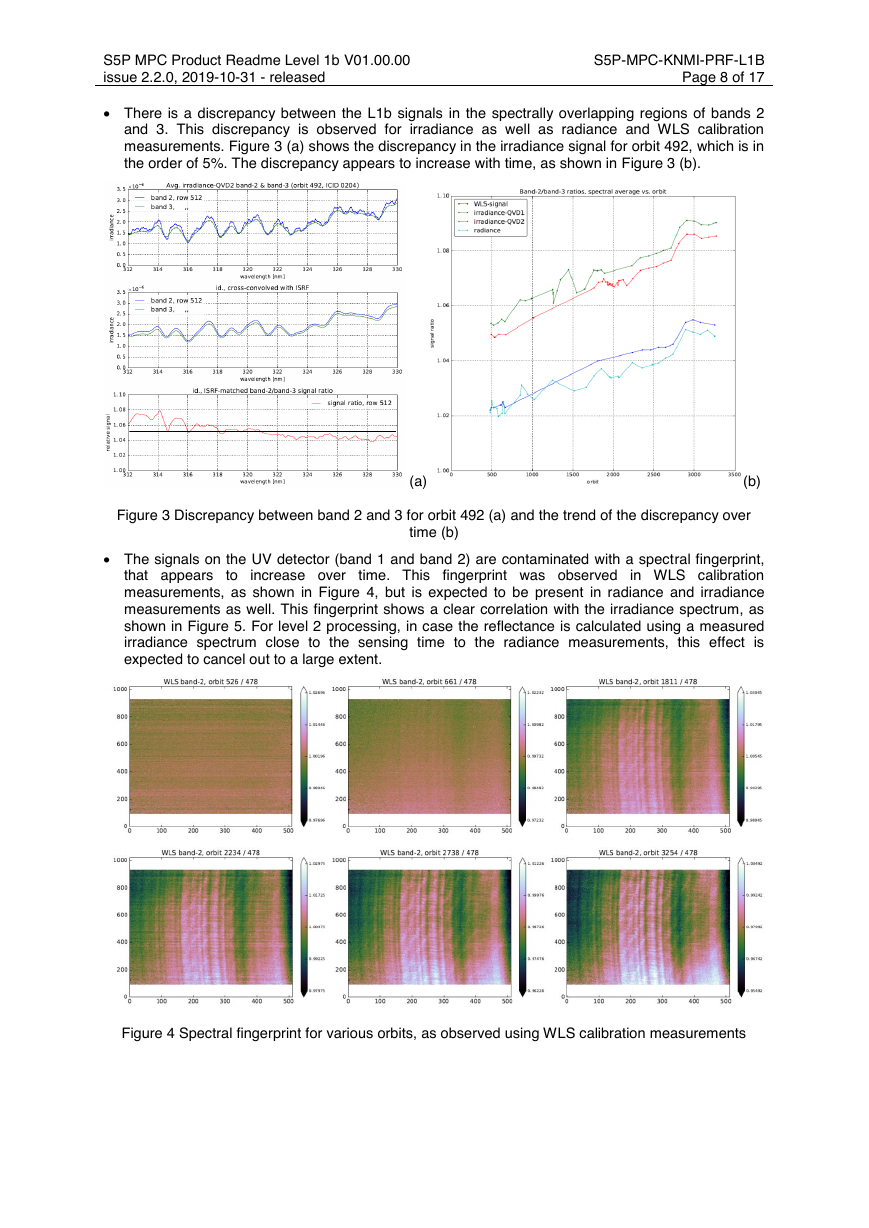S5P Mission Performance Centre
Level 1b Readme
L01b Design Lead
MPC ESL-L1 Product Lead
MPC ESL-L1b Product Contributor
MPC ESL-L1b Product Contributor
MPC ESL-L1b Product Contributor
ESA Data Quality Manager
ESA Mission Manager
document number
S5P-MPC-KNMI-PRF-L1B
2.2.0
2019-10-31
V01.00.00
released
N.C. Rozemeijer (KNMI)
Q. Kleipool (KNMI)
A. Ludewig (KNMI)
T. van Kempen (SRON)
R. van Hees (SRON)
A. Dehn (ESA)
C. Zehner (ESA)
issue
date
product version
status
Prepared by
Reviewed by
Approved by
�
S5P MPC Product Readme Level 1b V01.00.00
issue 2.2.0, 2019-10-31 - released
MPC Contributors
S5PVT1
Contributors
E. Loots (KNMI)
R. Bartstra (KNMI)
E. van der Plas (KNMI)
M. Weber (IUP)
G. Jaross (NASA)
J. Gleason (NASA)
G. Tilstra (KNMI)
S5P-MPC-KNMI-PRF-L1B
Page 2 of 17
MPC ESL-L1 Product Contributor
MPC ESL-L1 Product Contributor
MPC ESL-L1 Product Contributor
S5PVT, AO Project 28608
S5PVT, NASA Project, AO 28612
S5PVT, NASA Project, AO 28612
S5PVT, AO Project 28617
Signatures
C. Zehner (ESA) – Mission Manager
1 The S5PVT AO project summaries can be found at https://earth.esa.int/web/guest/pi-
community/search-results-and-projects/mission
XMPC Product Lead / PRF Lead EditorXA. Dehn (ESA)Data Quality Manager�
S5P MPC Product Readme Level 1b V01.00.00
issue 2.2.0, 2019-10-31 - released
1
Summary
S5P-MPC-KNMI-PRF-L1B
Page 3 of 17
This is the Product Readme File (PRF) for the Sentinel 5 Precursor Tropospheric Monitoring
Instrument (S5P/TROPOMI) Level 1b data products and is applicable for both the Near Real-Time
(NRTI) and Offline (OFFL) timeliness data products.
The S5p mission is a single-payload satellite in a low Earth orbit that provides daily global information
on concentrations of trace gases and aerosols important for air quality, climate forcing, and the
stratospheric ozone layer. The payload of the mission is the TROPOspheric Monitoring Instrument
(TROPOMI), which is jointly developed by The Netherlands and ESA. The instrument consists of a
spectrometer with spectral bands in the ultraviolet, the visible, the near-infrared and the shortwave
infrared, as detailed in Table 1. The wavelength range for TROPOMI allows observation of key
atmospheric constituents, including ozone (O3), nitrogen dioxide (NO2), carbon monoxide (CO), sulfur
dioxide (SO2), methane (CH4), formaldehyde (CH2O), aerosols and clouds.
Starting from orbit 9388 on 6 August 2019, a modification in the operations scenario increased the
spatial sampling in the flight direction. Due to this change the approximate footprint size in nadir
improved from 7 x 3.5 km2 to 5.5 x 3.5 km2.
Table 1 Main spectral characteristics of the four TROPOMI spectrometers and the definition of the
TROPOMI spectral bands with identifiers 1–8.
There are 2 different types of L1b data products available to users:
• L1b radiance products, containing earth radiance spectra. There is one L1b radiance product type
for each spectral band (product identifiers L1B_RA_BD1 through L1B_RA_BD8).
• L1b irradiance products, containing solar irradiance spectra. There are two L1b irradiance products
types. The first (product identifier L1B_IR_UVN) contains the solar irradiance spectra for the UVN
bands (band 1 through band 6). The second (product identifier L1B_IR_SIR) contains the solar
irradiance spectra for the SWIR bands (band 7 and band 8).
The L1b radiance and irradiance products are available to users in off-line (OFFL) timeliness. Off-line
data products contain one orbit worth of data.
Example filename:
S5P_OFFL_L1B_RA_BD4_20180703T020255_20180703T034425_03727_01_010000_20180703T053339.nc
This document describes the current processing baseline, product and quality limitations, and product
availability status. More information on this data product is available from the Sentinel product
webpage:
https://sentinels.copernicus.eu/web/sentinel/technical-guides/sentinel-5p/products-algorithms,
and from the TROPOMI product webpage http://www.tropomi.eu/data-products.
The L1B Mission data requirements are described in [MRD].
�
S5P MPC Product Readme Level 1b V01.00.00
issue 2.2.0, 2019-10-31 - released
2
Processing baseline description
S5P-MPC-KNMI-PRF-L1B
Page 4 of 17
This ReadMe applies to S5p/TROPOMI Level 1B data products, produced with L0-1b data processor
version 01.00.00 and calibration key data:
S5P_OPER_AUX_L1_CKD_20141001T000001_20501231T235959_00000_01_001200_20171010T1
43000.h5.
Table 2 contains the history of the processor versions.
Processor Version
In operation from
In operation until
01.00.00
orbit 2818, 2018-04-30
current version
Table 2: History of S5p Level 1B processor versions
�
S5P MPC Product Readme Level 1b V01.00.00
issue 2.2.0, 2019-10-31 - released
3
Product Quality
3.1
Recommendations for data usage
S5P-MPC-KNMI-PRF-L1B
Page 5 of 17
An overview of the Sentinel-5p mission, the TROPOMI instrument and the algorithms for producing
the L1b data products can be found in the Algorithm Theoretical Basis Document [ATBD]. Details of
the data format are provided in the Input/Output Data Specification [IODS]. The metadata contained in
the L1b data products are described in the Metadata Specification [MDS]. All these documents are
available
https://sentinels.copernicus.eu/web/sentinel/technical-guides/sentinel-5p/products-
algorithms.
on
For Level 2 processing, the following additional notices apply:
• The L0-1b data processor annotates the data with quality assessment data in the fields
spectral_channel_quality, measurement_quality and ground_pixel_quality. Level
2 developers are strongly encouraged to use these quality fields in their retrievals and exclude
flagged data as needed.
• All 8 bands are processed individually in the L0-1b data processor. In case of missing data, for
example in case of data drop-outs during downlinks, this does not necessarily impact all bands (to
the same extent). This means that a scanline can be missing for some bands, where it is not
missing for other bands. When combining data from multiple bands, Level 2 algorithm developers
should therefore always check and match the delta_time for these data and, in case of non-co-
registered bands, the geolocation as well.
• For calculating reflectance from the radiance products, it is recommended to use the irradiance
product with the sensing time closes to the sensing time of the radiance product.
3.2
Validation results
3.2.1
Status of product validation
This section presents a summary of the key validation results obtained by the Validation data Analysis
Facility (VDAF) of the S5p Mission Performance Centre (MPC) and by the S5p Validation Team
(S5PVT). It contains preliminary results reported at the S5p First Public Release Validation Workshop
(ESA/ESRIN, June 25-26, 2018). Individual contributions to the workshop are available in
https://nikal.eventsair.com/QuickEventWebsitePortal/sentinel-5p-first-product-release-
workshop/sentinel-5p, while up-to-date validation results and consolidated validation reports are
available through the MPC VDAF website at http://mpc-vdaf.tropomi.eu.
Current conclusions are based on the limited amount of reference measurements available at the time
of this first analysis, and on a period covered by the initial S5P dataset. The conclusions summarized
hereafter need to be confirmed by a larger amount of co-locations, and extended over a full year of
data, hence, a full cycle of key influence quantities, in order to enable detection and quantification of
potential patterns, dependences, seasonal cycles and longer term features.
3.2.2
Validation approach
The S5P/TROPOMI Level 1b products have been compared to models and other satellite instruments,
specifically EOS-Aura OMI and NPP OMPS.
3.2.3
Validation results
The validation of the wavelength assignment of the UVN L1b products shows agreement of 0.02 to
0.04 nm, which is within the pre-launch calibration accuracy.
Initial validation of the reflectance with OMI and OMPS data indicates that TROPOMI is within 5% for
the shorter wavelengths in band 3 and improving to 2% towards the longer wavelengths in band 4. For
the short wave UV in band 1 TROPOMI is within 8% +/-2% of the expected modeled reflectances. In
general radiometric errors in bands 1 and 3 are large but vary slowly over wavelength and most L2
retrievals are insensitive to such errors.
Additional validation indicates that for bands 3 to 7 the requirements [MRD] for the reflectance are met
if the uncertainty of the method of 3 to 5% is taken into account.
�
S5P MPC Product Readme Level 1b V01.00.00
issue 2.2.0, 2019-10-31 - released
The largest source of error in the reflectance is due to the initial pre-launch irradiance calibration. This
is a known issue and will be addressed in future updates.
S5P-MPC-KNMI-PRF-L1B
Page 6 of 17
The validation of the TROPOMI irradiance L1b product shows that it is within 3 to 10% depending on
the used reference spectrum and that there is a radiometric mismatch between band 2 and 3.
�
S5P MPC Product Readme Level 1b V01.00.00
issue 2.2.0, 2019-10-31 - released
4
Known Data Quality Issues
S5P-MPC-KNMI-PRF-L1B
Page 7 of 17
4.1
Radiometric calibration and degradation
Several issues have been identified with respect to the radiometric calibration of the instrument and
possible degradation:
•
Irradiance measurements show a spatial non-uniformity. This, non-uniformity is probably caused by
uncorrected setup straylight during on-ground calibration. Furthermore,
in-flight diffuser
degradation seems to result in an increase in the non-uniformity. The spatial non-uniformity (in this
case for the UVIS detector) is shown in Figure 1. Figure 1 (a) shows the measured solar irradiance
on the detector. In Figure 1 (b), the data are regridded to a fixed wavelength grid. In Figure 1 (c)
the irradiance is divided by the irradiance of the central detector row (corresponding to nadir),
showing the non-uniformity.
(a)
(b)
(c)
Figure 1 Spatial non-uniformity in irradiance measurements.
• There is a long-term downward trend in irradiance signal magnitude, probably due to diffuser
degradation. The drift is strongest for shorter wavelengths and negligible in NIR and SWIR.
However, there is also a low-frequency periodic additional signal on top of this drift. This second
drift is visible in UV, VIS and NIR. It even dominates the diffuser degradation for NIR. The
spectrally averaged drift is shown in Figure 2.
Figure 2 Temporal drift in the irradiance for UV (left), UVIS (middle) and NIR (right). The y-axis
corresponds with time (orbit) from top to bottom, the x-axis corresponds to detector row (ground-pixel
dimension)
�
S5P MPC Product Readme Level 1b V01.00.00
issue 2.2.0, 2019-10-31 - released
• There is a discrepancy between the L1b signals in the spectrally overlapping regions of bands 2
and 3. This discrepancy is observed for irradiance as well as radiance and WLS calibration
measurements. Figure 3 (a) shows the discrepancy in the irradiance signal for orbit 492, which is in
the order of 5%. The discrepancy appears to increase with time, as shown in Figure 3 (b).
S5P-MPC-KNMI-PRF-L1B
Page 8 of 17
Figure 3 Discrepancy between band 2 and 3 for orbit 492 (a) and the trend of the discrepancy over
time (b)
(a)
(b)
to
increase over
• The signals on the UV detector (band 1 and band 2) are contaminated with a spectral fingerprint,
that appears
in WLS calibration
measurements, as shown in Figure 4, but is expected to be present in radiance and irradiance
measurements as well. This fingerprint shows a clear correlation with the irradiance spectrum, as
shown in Figure 5. For level 2 processing, in case the reflectance is calculated using a measured
irradiance spectrum close to the sensing time to the radiance measurements, this effect is
expected to cancel out to a large extent.
fingerprint was observed
time. This
Figure 4 Spectral fingerprint for various orbits, as observed using WLS calibration measurements
�
















 2023年江西萍乡中考道德与法治真题及答案.doc
2023年江西萍乡中考道德与法治真题及答案.doc 2012年重庆南川中考生物真题及答案.doc
2012年重庆南川中考生物真题及答案.doc 2013年江西师范大学地理学综合及文艺理论基础考研真题.doc
2013年江西师范大学地理学综合及文艺理论基础考研真题.doc 2020年四川甘孜小升初语文真题及答案I卷.doc
2020年四川甘孜小升初语文真题及答案I卷.doc 2020年注册岩土工程师专业基础考试真题及答案.doc
2020年注册岩土工程师专业基础考试真题及答案.doc 2023-2024学年福建省厦门市九年级上学期数学月考试题及答案.doc
2023-2024学年福建省厦门市九年级上学期数学月考试题及答案.doc 2021-2022学年辽宁省沈阳市大东区九年级上学期语文期末试题及答案.doc
2021-2022学年辽宁省沈阳市大东区九年级上学期语文期末试题及答案.doc 2022-2023学年北京东城区初三第一学期物理期末试卷及答案.doc
2022-2023学年北京东城区初三第一学期物理期末试卷及答案.doc 2018上半年江西教师资格初中地理学科知识与教学能力真题及答案.doc
2018上半年江西教师资格初中地理学科知识与教学能力真题及答案.doc 2012年河北国家公务员申论考试真题及答案-省级.doc
2012年河北国家公务员申论考试真题及答案-省级.doc 2020-2021学年江苏省扬州市江都区邵樊片九年级上学期数学第一次质量检测试题及答案.doc
2020-2021学年江苏省扬州市江都区邵樊片九年级上学期数学第一次质量检测试题及答案.doc 2022下半年黑龙江教师资格证中学综合素质真题及答案.doc
2022下半年黑龙江教师资格证中学综合素质真题及答案.doc